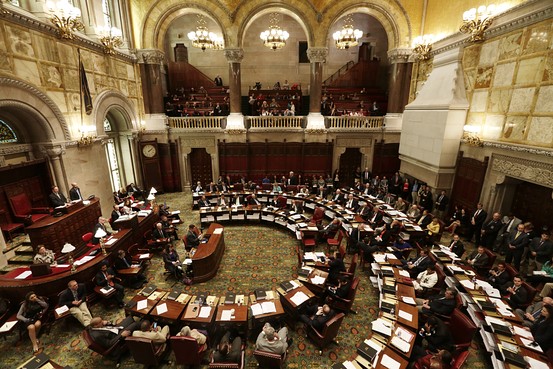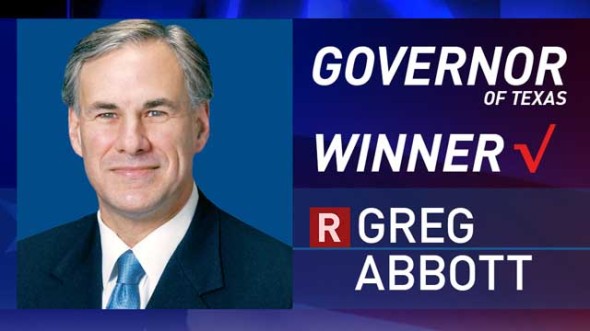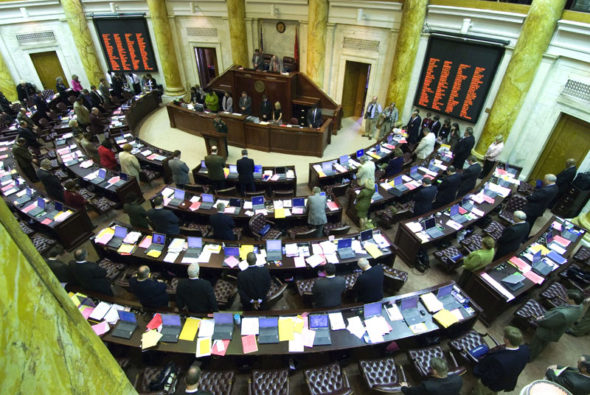Republicans gain largest majorities in decades in state capitols, plan push for more tax cuts
Daily News Article — Posted on November 6, 2014

The New York State Senate Chamber at the Capitol in Albany, N.Y. (AP Photo/Mike Groll)
(by David A. Lieb, Associated Press) KANSAS CITY, Mo. — State capitols across the country will be more Republican than at any point since the 1920s when victorious legislators and governors take office next year. …
A day after a big election, newly emboldened Republican state leaders already were making plans Wednesday to pursue deeper tax cuts, relax business regulations, expand…school vouchers and impose new limits on public welfare programs.
In some states, such as Kansas, Republicans will be able to do as they [and the majority of voters who elected them] want, because they control both chambers of the legislature and the governor’s office. In others, such as neighboring Missouri, the Republicans’ legislative supermajorities will be so large that they can essentially disregard the objections of a Democratic governor. Elsewhere, like in New York, the Republican takeover of one legislative chamber simply means a stronger say in a state still otherwise led by Democrats.
Nowhere in the entire nation did Democrats take over a legislative chamber previously held by Republicans. And Pennsylvania Gov. Tom Corbett was the only Republican chief executive to fall to a Democratic challenger.
For statehouse Republicans, “it’s their strongest position in nearly a century,” said Tim Storey, an analyst at the National Conference of State Legislatures.
Republicans will have full control of at least 28 state legislatures (both chambers: state Senate and State House), their largest total since 1928. The GOP will hold at least 32 governorships, including newly won offices in traditionally Democratic Illinois, Maryland and Massachusetts.
In many cases, the Republican victories expanded majorities won in previous elections, such as the 2010 GOP sweep. Over the past several years, Republicans already have used those majorities to cut taxes, restrict abortions, expand gun rights and limit the powers of public employee unions.
Those all remain high on the Republican agenda.
“We’re going to focus on legislation that helps small businesses, whether that’s taxes, labor or the regulatory environment,” said Missouri House Speaker-nominee John Diehl, whose Republican caucus now holds its highest-ever number of seats. …
In Kansas, Republican Gov. Sam Brownback narrowly won, as Republicans added to their ranks in the House. In recent years, large GOP majorities in Kansas enacted widespread income tax cuts. Gov. Brownback acknowledged at a victory party that “it’s a difficult time for many Kansas families” and “jobs are scarce,” but he pledged to keep the state on the route he had charted. “Our way is holding down taxes, holding down regulations, controlling spending,” Brownback said.
Republican governors or legislative leaders in Maryland, Maine, New York, Texas and West Virginia also are already talking of tax cuts.

Texas Gov.-elect Greg Abbott has promised to make an expansion of school vouchers and charter schools a priority for his new Republican administration that will be paired with an even larger GOP majority in the House and Senate.
Wisconsin Gov. Scott Walker, who won re-election along with an expanded GOP legislative majority, also wants to expand enrollment in a private school voucher program. His agenda includes drug tests for people seeking food stamps or unemployment benefits and more tax cuts on top of the $2 billion enacted during his first term.
In Maine, Assistant Republican Senate Leader Roger Katz said that the new GOP-led Senate hopes to team with re-elected Republican Governor Paul LePage to implement “sensible” changes to welfare programs, cut government spending, lower taxes and eliminate bureaucracy for businesses.

Arkansas House of Representatives
The Republican victory in Arkansas was the largest since Reconstruction, with GOP candidates sweeping the statewide offices and building upon its legislative majorities. [The Washington Post reported: “Republicans now have every congressional seat for Arkansas for the first time in 141 years.”] Republicans will have to decide whether to continue a program enacted under Democratic Gov. Mike Beebe that expanded health coverage to more than 200,000 people by using Medicaid money to buy private insurance.
“With these victories by the new Republicans – many of whom have voiced opposition to that – it really puts it in some real danger,” said Jay Barth, a political science professor at Hendrix College in Conway, Arkansas. “The big test initially is what happens to the private option.”
Reprinted here for educational purposes only. May not be reproduced on other websites without permission from The Associated Press. Visit the website at ap .org.
Background
The Wall Street Journal reports:
- For Democrats, it’s been more than 150 years since the party controlled so few state legislatures.
- Many of the wins for the GOP came in states that President Barack Obama won two years ago, including both chambers in Nevada, the New Mexico House, New Hampshire House, New York Senate and Minnesota House.
- Tim Storey, an analyst at the National Conference of State Legislatures said, “Republicans exceeded all expectations. The margins and scope are really extraordinary.”
USA Today reported: "Nearly every race that was in doubt fell the Republicans' way:
- In Kansas, embattled GOP Sen. Pat Roberts withstood a strong challenge from Greg Orman, an independent backed by Democrats.
- Republican Rep. Shelley Moore Capito won the seat of retiring Democratic Sen. Jay Rockefeller in West Virginia, a state that has drifted Republican in recent elections. She called her victory "a turning point'' for West Virginia. "It's the first time in 60 years we have sent a Republican to the U.S. Senate,'' Capito said. She is also the first woman the state has elected to the U.S. Senate.
- In Arkansas, Republican Tom Cotton ousted Democratic Sen. Mark Pryor.
- In South Dakota, Republican Mike Rounds defeated Democrat Rick Weiland and an independent campaign by former GOP senator Larry Pressler.
- In Montana, Republican Steve Daines easily defeated Democrat Amanda Curtis.
- And in Colorado, Republican Rep. Cory Gardner ousted Democratic Sen. Mark Udall.
- In one of the most closely watched races, North Carolina Democratic Sen. Kay Hagan narrowly lost a close fight with Republican Thom Tillis, speaker of the state House.
- And in Iowa, Republican Joni Ernst won a Senate seat previously held by Democrats.
- Republican Mitch McConnell won easy re-election in Kentucky, where Democrats once hoped for a major upset. Challenger Alison Lundergan Grimes conceded to McConnell in a phone call, her campaign said. "This was certainly a hard-fought contest,'' McConnell said in claiming victory.
- In Georgia, Republican David Perdue defeated Democrat Michelle Nunn to succeed retiring GOP Sen. Saxby Chambliss.
- In one of the few closely watched races that Democrats could celebrate, Sen. Jeanne Shaheen of New Hampshire fought off a challenge from Republican Scott Brown, a former senator from neighboring Massachusetts.
ON STATE LEGISLATURES:
- A state legislature in the U.S. is the legislative body of any of the 50 states. The formal name varies from state to state.
- In 25 states, the legislature is simply called the Legislature, or the State Legislature, while in 19 states, the legislature is called the General Assembly. In Massachusetts and New Hampshire, the legislature is called the General Court, while North Dakota and Oregon designate the legislature the Legislative Assembly.
- Every state except Nebraska has a bicameral legislature, meaning that the legislature consists of two separate legislative chambers or houses.
- In each case the smaller chamber is called the Senate and is usually referred to as the upper house. This chamber typically, but not always, has the exclusive power to confirm appointments made by the governor and to try articles of impeachment. (In a few states, a separate Executive Council, composed of members elected from large districts, performs the confirmation function.)
- Members of the smaller chamber represent more citizens and usually serve for longer terms than members of the larger chamber, generally four years.
- In 41 states, the larger chamber is called the House of Representatives. Five states designate the larger chamber the Assembly and three states call it the House of Delegates. Members of the larger chamber usually serve for terms of two years. The larger chamber customarily has the exclusive power to initiate taxing legislation and articles of impeachment.
- Prior to United States Supreme Court decisions Reynolds v. Sims and Baker v. Carr in the 1960s, the basis of representation in most state legislatures was modeled on that of the U.S. Congress: the state senators represented geographical units while members of the larger chamber represented population. In 1962, the United States Supreme Court announced the "one person, one vote" standard and invalidated state legislative representation based on geography. (The ruling does not affect the U.S. Senate because that chamber's makeup is prescribed by the U.S. Constitution.) (from wikipedia)
